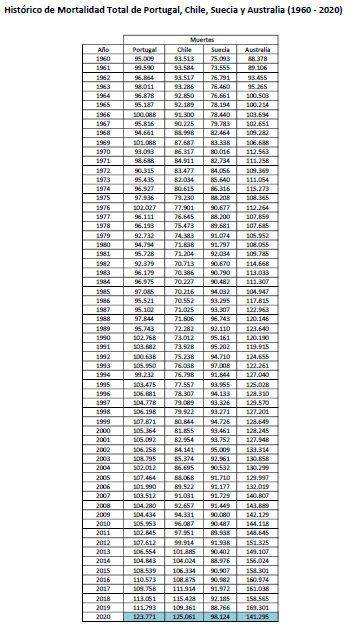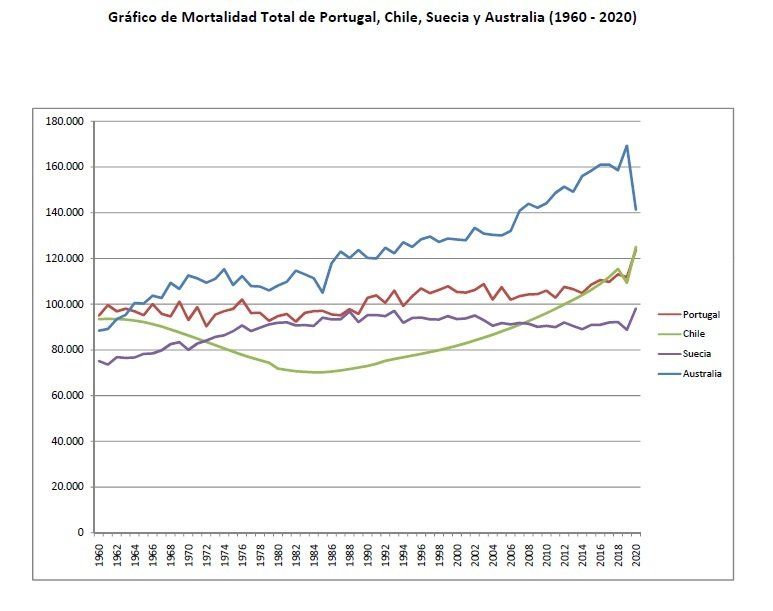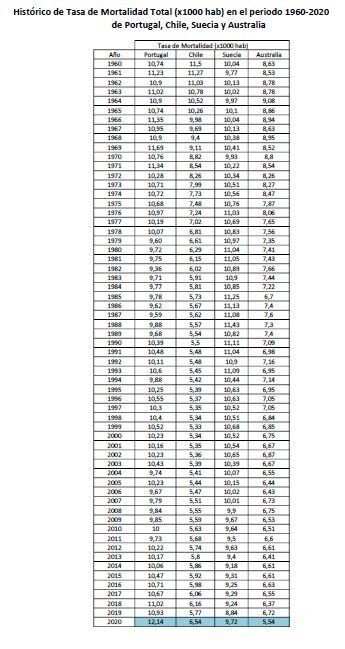Comparative Mortality Analysis by Country Groups -
Long Term Outlook
Group 2: Portugal, Chile, Sweden and Australia
With the data from the previous Post in relation to Total Mortality between 1960 and 2020 we make a joint table of Mortality between 1960 and 2020 for Portugal, Chile, Sweden and Australia:
In this graph it can already be seen that similar countries in population have had unequal behaviors in the last 60 years. In this graph we observe something in common to the 4 countries, even having taken different paths, they have a positive balance of Mortality in the analyzed period, that is, in the 4 countries mortality has increased in the analyzed period, and 3 of them are at historical highs (of the analyzed period). Be careful, this does not mean that it is good or bad, it is simply an objective data. It is significant for us as even having totally different intermediate behaviors in the 4 countries, in the end the long term is in charge of regulating or correcting the differences, in relation to Total Mortality.
Next, we proceed to calculate the annual Mortality Rates for each country, using the data from the website www.macrotrends.net.
I leave here, for those who are interested, the sources and specific calculations made for each country in relation to the calculation of the Annual Total Mortality Rate between 1960 and 2020 in the following links:
With the data of the annual Total Mortality Rates for each country, the table of Total Mortality Rate (1960 - 2020) will be generated as a whole, as well as their respective graphs with the Total Mortality Rate as a whole for this period.
Comment on the Mortality Rate some interesting points:
- It is common to read that to compare Mortalities between countries it is better to use the Mortality Rate than the Mortality itself, since it includes the size of each population and can compare them appropriately. This is true, but it must be borne in mind that including the “population” factor, or more specifically the annual evolution of the annual population of a territory or a country, includes in itself other added concepts such as births as opposed to deaths as well as immigration as opposed to emigration. Elements that would require a more complex treatment and that we are not going to analyze in depth.
For this reason, we want to highlight that the Total Mortality graphs for the study of Mortality itself seem more reliable for the long term than the Mortality Rate itself, which has these added concepts.
In fact, as you can see in the graphs, the results of Mortality and Mortality Rate are usually very different, since they reflect these other concepts that we have mentioned.
- Another way to see how the Mortality Rate acts, would be understanding that if the rate of growth of mortality is adjustable to the rate of growth of the population of a country, the rate of mortality would be neutral or constant over time. Therefore, the Mortality Rate also measures how the growth of mortality varies in relation to the growth of the population of a country.
- In some way, the study in terms of Mortality Rate also means that Mortality variations are not directly appreciated, and the degree of detail obtained with the Mortality study is hardly reflected in the Mortality Rate itself, at least in the long-term study.
Analysis of the overall graph of the Total Mortality Rate in relation to the Total Mortality Rate:
There will be people who are experts in the field who can get more out of these graphs than we can, but we will try to provide a brief conclusion or common sense reasoning:
Regarding Portugal: We see that the Mortality Rate in Portugal has been quite lateral or neutral, until this last year 2020, in which it has reached the highest of the study period. Looking at its Total Mortality graph, we see that it has been rising little by little, until 2016, in which it exceeds its previous maximums and already in 2020 it reaches historical maximums (of the study period) by surpassing its previous maximum of 2018. Its population has grown little, compared to other countries. In fact, in recent years its population is decreasing. This may be helping to raise your Total Death Rate.
Regarding Chile: The Mortality Rate in Chile has fallen until the mid-1980s, subsequently it has remained more or less lateral. Chile's population has grown almost steadily over the past 60 years. Relating the Graph of Total Mortality we see that when it fell until the 1980s, together with the growth of the population, it drove the decrease in the Mortality Rate. As of the mid-1980s, Mortality began to grow in synchronization with the increase in the population, so that the Mortality Rate has been practically lateral since that date.
Regarding Sweden: The Mortality Rate in Sweden grew until the end of the 80s and subsequently fell steadily until this year 2020, when it has risen a lot, although below its historical maximums (in the study period). Sweden's population has grown slowly but positively over the past 60 years. Mortality has been quite contained until this year 2020, which has risen, narrowly reaching historical highs for the period analyzed.
Regarding Australia: The Mortality Rate in Australia has been decreasing from the 1960s to the present, leaving this year 2020 a historical minimum (in the study period). This downward trend contrasts with the trend in Total Mortality, which has grown a lot from 1960 to 2019, where it is its historical maximum for the period analyzed, and collapsing in this pandemic year 2020, unlike most of the countries analyzed. The explanation for these contrary trends is due to the fact that Australia's population has grown a lot in the last 60 years, 150% in this period. We understand that this has been decisive so that, although Mortality has had an upward trend, the Mortality Rate reflects a downward trend, because the annual population growth has been greater than the annual growth of total mortality during the analysis period. .
CTA Street Wear Blog




All Rights Reserved | Critical Thinking Attitude Street Wear









